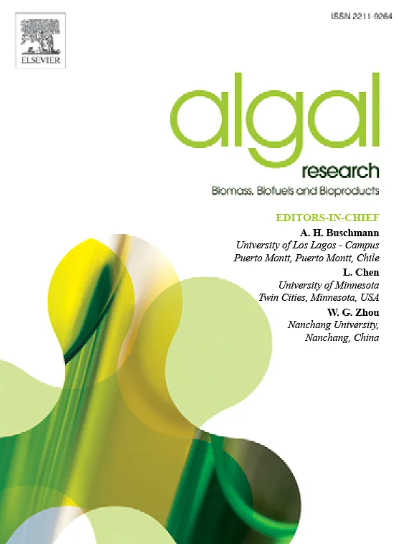Near-infrared spectroscopy for microalgae studies: A comprehensive review of applications and outlooks
IF 4.6
2区 生物学
Q1 BIOTECHNOLOGY & APPLIED MICROBIOLOGY
Algal Research-Biomass Biofuels and Bioproducts
Pub Date : 2025-04-30
DOI:10.1016/j.algal.2025.104074
引用次数: 0
Abstract
Microalgae are photosynthetic organisms typically found in natural freshwater and marine environments. They are important in wastewater treatment for pollution removal and resource recovery. Due to species-specific differences in physiological structure and biochemical composition, microalgae exhibit complex internal metabolisms and dynamic interactions with external environmental factors. However, many of their traits such as components, elements, and genetic information, and key mechanisms including growth and development, metabolism, and toxicological responses, remain insufficiently understood. As an effective, efficient, accurate, and nondestructive optical method, near-infrared (NIR) spectroscopy has great potential for studying microalgal properties. Considering the lack of literature reviews in this field, this paper highlights NIR applications on microalgae from three major categories: components testing, growth monitoring, and contaminants supervision using microalgae as a mediating object. It also discusses the existing challenges and future directions from aspects of microalgae, NIR, predictive modeling, and sustainability. Overall, this review aims to provide a comprehensive overlook and promote further advances at the intersection of microalgae research and NIR spectroscopy.
近红外光谱在微藻研究中的应用综述及展望
微藻是一种光合生物,通常存在于天然淡水和海洋环境中。它们在污水处理中具有去除污染和回收资源的重要作用。由于物种间生理结构和生化组成的差异,微藻表现出复杂的内部代谢和与外界环境因素的动态相互作用。然而,它们的许多特性,如成分、元素和遗传信息,以及包括生长发育、代谢和毒理学反应在内的关键机制,仍未得到充分的了解。近红外光谱作为一种有效、高效、准确、无损的光学方法,在研究微藻性质方面具有很大的潜力。鉴于该领域文献综述较少,本文以微藻为中介对象,从成分检测、生长监测和污染物监测三大类重点介绍了近红外技术在微藻上的应用。并从微藻、近红外、预测建模和可持续性等方面讨论了当前面临的挑战和未来的发展方向。综上所述,本文旨在对微藻研究与近红外光谱研究的交叉领域进行全面的回顾和展望。
本文章由计算机程序翻译,如有差异,请以英文原文为准。
求助全文
约1分钟内获得全文
求助全文
来源期刊

Algal Research-Biomass Biofuels and Bioproducts
BIOTECHNOLOGY & APPLIED MICROBIOLOGY-
CiteScore
9.40
自引率
7.80%
发文量
332
期刊介绍:
Algal Research is an international phycology journal covering all areas of emerging technologies in algae biology, biomass production, cultivation, harvesting, extraction, bioproducts, biorefinery, engineering, and econometrics. Algae is defined to include cyanobacteria, microalgae, and protists and symbionts of interest in biotechnology. The journal publishes original research and reviews for the following scope: algal biology, including but not exclusive to: phylogeny, biodiversity, molecular traits, metabolic regulation, and genetic engineering, algal cultivation, e.g. phototrophic systems, heterotrophic systems, and mixotrophic systems, algal harvesting and extraction systems, biotechnology to convert algal biomass and components into biofuels and bioproducts, e.g., nutraceuticals, pharmaceuticals, animal feed, plastics, etc. algal products and their economic assessment
 求助内容:
求助内容: 应助结果提醒方式:
应助结果提醒方式:


